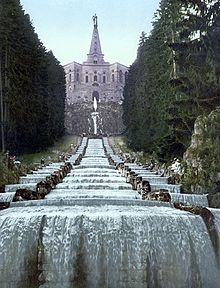
Water running down the cascades, a colored picture before 1903.
Bergpark Wilhelmshohe is the largest hillside park in Europe and can be found in Kassel, Germany. At 590 acres (2.4 square kilometers), the historical tract is the second largest hill slope park in the world. Beginning in 1689, the project would take a full 150 years to complete. Commissioned by the Landgraves of Hesse-Kassel, the park became a World Heritage Site in 2013. Bergpark Wilhelmshohe is the 13th stop, in the ongoing series A World Far And Away.
Begun by Landgrave Carl of Hesse-Kassel, the Bergpark (mountain park) Wilhelmshohe, was constructed on an east to west axis, which would continue to develop and expand into the 19th century.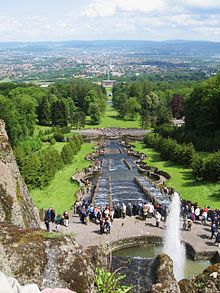
The original ensemble of the Bergpark, was an outstanding demonstration of man’s mastery over nature. It also provided a magnificent panoramic view, of the city of Kassel.
The original Baroque design of the Italian and French formal gardens would be later re-arranged into an English landscape garden. The enlargement was to create more naturalized gardens in the late 1700’s. This change in style, explains the small ponds and secluded enchanting areas, that can now be found throughout the park.
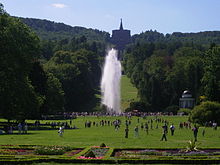
Great Fountain
The 18th century additions engineered by Carl’s great-grandson, the Elector Wilhelm I, constitute an expression of ideals and aesthetics, that were being promoted in garden design, during the growing Romantic movement. These idealistic emotions and feelings, would peak during the first half of the 1800’s.
In 1785, the Elector was said to have inherited, one of the largest fortunes in Europe, at the time.
This massive wealth was already being well managed by family of Rothschild. The money accumulated from these estates, provided ample financial resources, for the expansion of the Bergpark gardens.
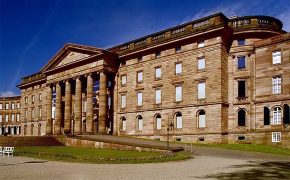
Wilhelmshohe Palace
The following year, the Elector had his architect design the neoclassical palace of Schloss Wilhelmshohe. Later in history, William II, the King of Prussia and the last German Emperor, would use the former Elector’s abode, as his summer residence.
Today, the palace houses an Old Masters Gallery, which focuses on the 16th and 17th centuries, containing masterpieces by German, Italian, French and Spanish painters. The well known “The Man with the Slouch Hat” by Frans Hals are among them.
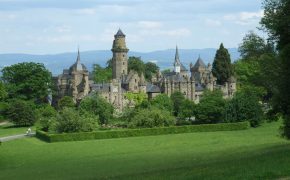
The Lion Castle
The assemblage includes paintings by Rembrandt, the second largest collection from the artist in all of Germany. Rembrandt’s famous “Saskia” can be found here.
There is also an aggregation of Greco-Roman antiquities and the Weissenstein Museum.
The Lowenburg (the Lion Castle) within the same park was built in 1793, for the Elector and his mistress. The building became his place of personal retreat. He is buried in a crypt under the castle’s chapel.
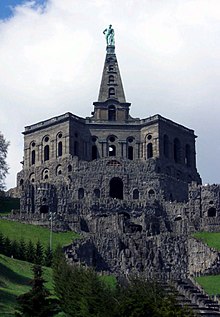
The Hercules – the Kassel landmark.
Lion Castle comes complete with medieval features like a moat and a drawbridge. The interior contains authentic Middle Ages fixtures and numbers of rare and unique artifacts.
As one of the most impressive Baroque parks globally, the Bergpark Wilhelmshohe contains numerous unique landscape architectural monuments. Among the most noteworthy, is a Roman aqueduct, with a 141 feet (43 meters) high artificial waterfall. The water cascades down the hill for over 1148 feet or 350 meters.
Above the falls, the most popular site within the Bergpark is the 231 (70.5 meters) high Hercules Monument. A statue of the demigod stands on top of a pyramid, which is on top of an octagon. There are more than 200 steps, leading to the top.
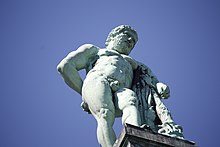
Close-up of Hercules monument, Kassel
Construction of Hercules Monument was begun in 1701 and finished in 1717 by a design from the Italian architect Giovanni, Francesco Guerniero. It was artistically and technically, the most colossal and sophisticated statue of the Early Modern Era.
The solid copper 27 foot (8.25 meter) statue of Hercules itself, can still be seen, from many miles away.
Reservoirs and channels behind the Hercules Monument, have been designed to supply water for an intricate system of hydro-pneumatic devices. These are all employed in creation of the large Baroque water theater, grotto, fountains, and the aforementioned, Grand Cascade.
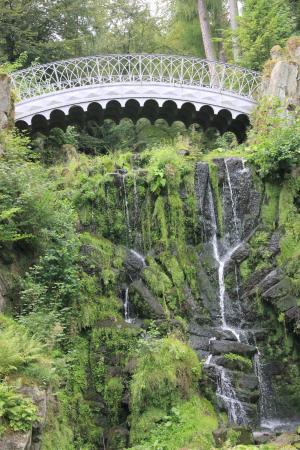
Devil’s Bridge Waterfall
The whole system relies on natural pressure from reservoirs and underground pipes, whose locks are opened manually. It has been in operation for over 300 years.
Other waterways feed a provide for a series of dramatic waterfalls and wild rapids.
Another major focal point is the almost geyser like Great Fountain, which propels water up to 164 feet (50 meters) high. Built in 1767, it was known as the tallest fountain in the world, at the time.
Additional channels of water lead to a number of secluded ponds and a lake.
The Bergpark Wilhelmshohe, contains over 600 different types of trees.
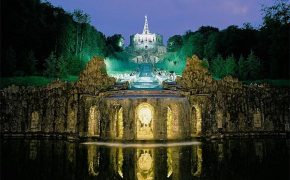
Cascades in the evening hours,
During the summer from May until October every Wednesday and Sunday afternoon, visitors can attend the main water features event. Every time about 92,000 gallons (350,000 liters) of water are needed.
Tourists can follow the water’s path downward, from the Hercules Monument via the Vexing Grotto and Artichoke Basin with their marvelous acoustic effects, onto Felsensturz Waterfall and Giant’s Head Basin.
The water then runs down the Baroque Cascades, the Steinhofer’s Waterfall, and the devil’s bridge, until it tumbles down the aqueduct before arriving at Neptune’s Basin before the lake. This is next to the castle of Wilhelmshohe, where the Great Fountain ends this wondrous presentation.
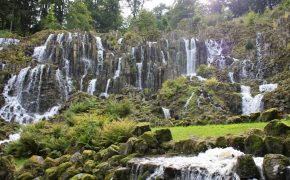
Steinhofer’s Waterfall
Additionally, every first Saturday of the months, of June, July, August and September, the same event takes place in the evening. There are lights of various colors illuminating from the water, the fountain and the different monuments. These water based displays, are just simply magical.
Schloss Wilhelmshohe was damaged by Allied bombs during World War II. It was refurbished into an art museum from 1968 to 1974. No extensions were made to the park in the 20th century, so most of the grounds look like they did in the 1800’s
Location
Kassel, Hesse, Germany
Bad Wilhelmshohe a Stadtteil of Kassel in Northern Hesse. Situated west of the city center, at the foot of the Habichtswald hill range.
Address: Bergpark Wilhelmshohe, Schlosspark 1, 34131 Kassel, Germany
Phone: +49 561 31680123
Fax: 0561 31680-111
Email– info[at]museum-kassel.de
Getting There
At the Kassel-Wilhelmshohe station on the Hanover-Wurzburg high speed rail-line.
Admission
Bergpark Wilhelmshohe is free of charge.
Hercules Monument and Octagon (platform and Pyramid)
3 Euros or $3.40 USD (United States Dollar) – children and those under 18 are free
Wilhelmshohe Palace: 6 Euros ($6.80 USD) with a reduced rate of 4 Euros ($4.54 USD)- children and those under 18 are free. Audio guide available for Old Masters Picture Gallery and the Antiquities Collection (German/English) 3 Euros
Lowenburg Castle including tour 2 Euros ($2.27 USD) – reduced 1 Euro ($1.13 USD) – children and those under 18 are free.
Days and Hours of Operations
Bergpark Wilhelmshohe is open all year.
Visitor Center Wilhelmshohe:
April 01 – October 31—-Tuesday – Sunday 10:00 am – 5:00 pm November 01 – March 31: Friday – Sunday and public holidays 10:00 am – 4:00 pm
Visitor Center Hercules–Tuesday – Sunday and public holidays 10 am – 5 pm
Hercules Monument and Octagon (platform and Pyramid)
April 01 – October 31 Tuesday – Sunday and public holidays 10 am – 5 pm
Tickets are available until 4:20 pm, last entrance 4:30 pm. Subject to weather-related changes. Closed during winter months.
Wilhelmshohe Palace: Tuesday – Sunday and public holidays 10:00 am – 5 pm Wednesday until 8 pm.
There are a number of other attractions on the site, that are open for similar days and hours.
Lowenburg Castle: April 01 – October 31 Tuesday – Sunday and public holidays 10:00 am – 5:00 pm (last tour at 4:00 pm)
November 01 to March 31 Friday – Sunday and public holidays 10:00 am – 4:00 pm (last tour at 3:00 pm)
At present there is a large-scale restoration in progress, so only the Armory and the Chapel are open to visitors. Ticket prices have been reduced as a result.
Lodging
Is available throughout the city of Kassel.
Valuable Tips
- It will be far more crowded during the summer months, and during holiday periods, when more people are on vacation. If possible, plan your trip during the off season.
- Not all sidewalks are scattered in the winter months.
- There have been extensive renovations to the Cascades and the Hercules monument, which are still ongoing.

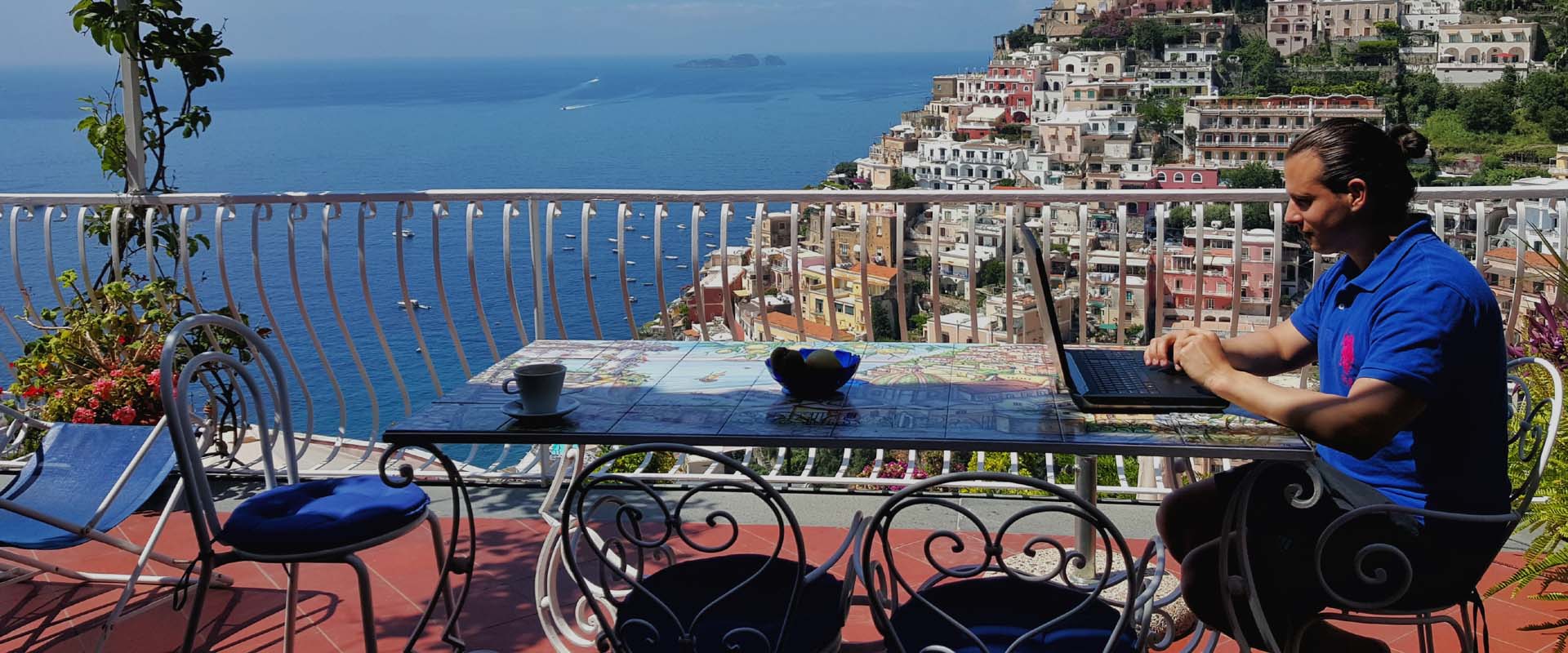
Thank you for this article. It’s very informative and very accurate as well. The photos are just amazing and the place too. I wish I could go there one day.
Brilliant post. Have noted this post, and looks like I will be visiting Germany before the end of this year.
Lovely blog, and nice template 🙂
Thanks for the information, the photos looks so beautiful. I will plan to visit the place soon.
According to title Historical Bergpark Wilhelmshohe of Kassel, Germany. The post was so nice, I have loved to visit these places ASAP. Traveling is the one best hobby of every third person.
so much motivational post.thank you
This is a nice article. Thanks for sharing. I would like to visit the place once the lockdown is over.
Such a lovely article!